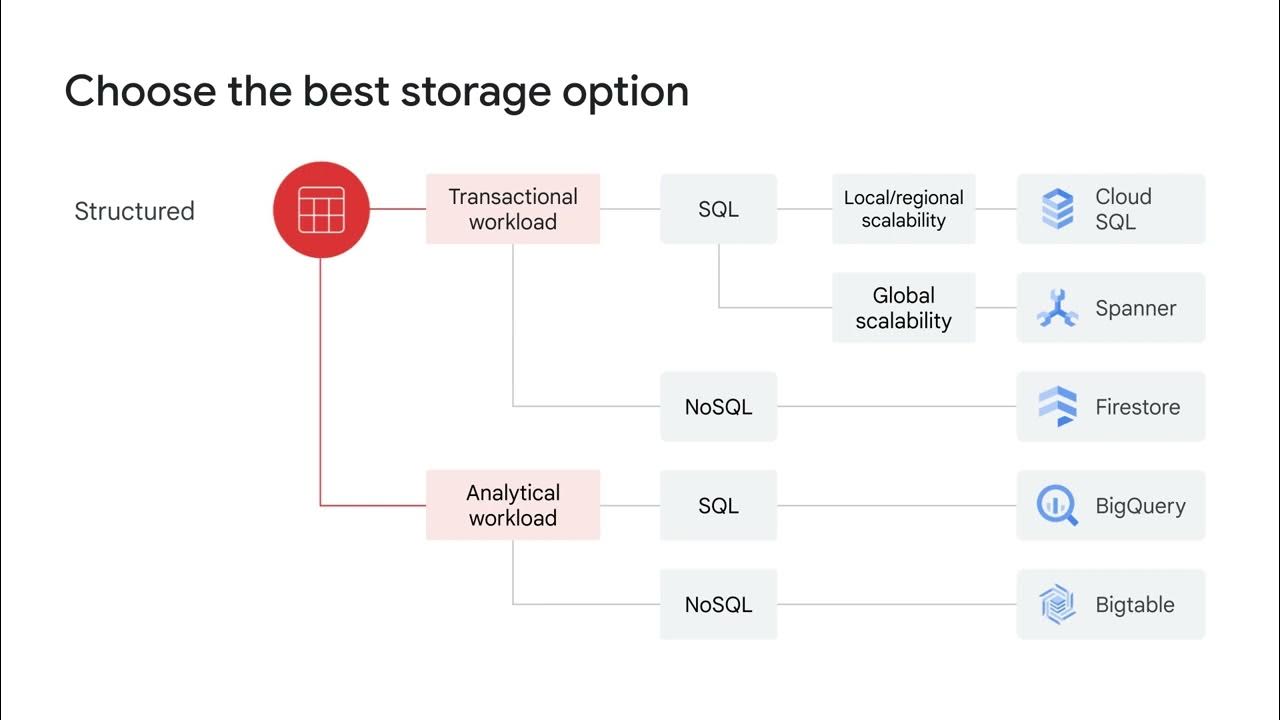Transactional vs. Analytical Workloads
Summary
TLDRThis video script delves into the distinction between transactional and analytical workloads in data management. Transactional workloads, exemplified by OLTP, focus on day-to-day operations like purchases and bank balance checks, emphasizing real-time processing and concurrency. Analytical workloads, or OLAP, aggregate data to uncover trends and inform business decisions, operating at a potentially slower pace but offering strategic insights. The script illustrates the symbiotic relationship between OLTP databases and OLAP data stores, culminating in data-driven decision-making that benefits the customer.
Takeaways
- 📈 Transactional and analytical workloads represent two distinct ways of handling data, each with different purposes and properties.
- 🛒 Transactional workloads, also known as OLTP (Online Transaction Processing), deal with day-to-day operational data such as purchases, bank balance checks, and reservations.
- 🕒 Real-time processing is crucial for transactional workloads to ensure customer satisfaction and efficient business operations.
- 🔄 Concurrency is a key feature of OLTP databases, allowing multiple users to access and interact with the database simultaneously.
- 🔑 CRUD operations (Create, Read, Update, Delete) are fundamental to OLTP databases, enabling the management of individual records and data entries.
- 📊 Analytical workloads, or OLAP (Online Analytics Processing), focus on aggregated data to identify trends and support business decision-making.
- 📚 OLAP data stores are slower than OLTP databases due to the complexity of analyzing large datasets but provide valuable insights for strategic planning.
- 🔗 There is a symbiotic relationship between OLTP databases and OLAP data stores, with transactional data feeding into the analytical process.
- 🏢 An enterprise data warehouse (EDW) serves as a central repository for aggregated data from multiple OLTP databases within a company.
- 📉 Analytical information helps in understanding the overall trends and performance of an organization, guiding strategic business decisions.
- 🔄 The process from transactional data capture to analytical insights and decision-making completes a cycle that ultimately benefits the customer.
Q & A
What is the main difference between transactional and analytical workloads?
-Transactional workloads, also known as OLTP (Online Transaction Processing), focus on day-to-day operational information and real-time processing, such as customer purchases or bank balance checks. Analytical workloads, or OLAP (Online Analytics Processing), focus on data aggregation to understand trends and make business decisions.
Why is real-time processing important in transactional workloads?
-Real-time processing is crucial for transactional workloads because it ensures immediate updates and responses to customer actions, such as purchases, which enhances customer satisfaction and operational efficiency.
What is the significance of concurrency in OLTP databases?
-Concurrency in OLTP databases allows multiple users to access the database simultaneously, improving efficiency and reducing wait times, which is essential for handling high volumes of transactions in a timely manner.
What are CRUD operations and how do they relate to OLTP databases?
-CRUD stands for Create, Read, Update, and Delete. These operations are fundamental to OLTP databases, allowing for the management of records such as creating a new customer record, reading bank balance information, updating address details, and deleting unwanted subscriptions.
How does an OLAP data store differ from an OLTP database in terms of data focus?
-An OLAP data store focuses on aggregated data to analyze trends and support business decision-making, whereas an OLTP database focuses on individual transactions and entities for operational purposes.
What is the role of an enterprise data warehouse (EDW) in the context of OLAP?
-An enterprise data warehouse (EDW) serves as a central repository that aggregates data from multiple OLTP databases, providing a holistic view of the organization's data to facilitate informed decision-making.
How is the information from OLTP databases utilized in an OLAP data store?
-Information from OLTP databases is consolidated and transferred to an OLAP data store, where it is used to analyze patterns and trends across the organization, aiding in strategic business decisions.
What is the relationship between a customer making a purchase and the OLTP and OLAP systems?
-When a customer makes a purchase, the transaction is recorded in an OLTP database for immediate processing. Later, this data is transferred to an OLAP data store, where it contributes to aggregated data used for analyzing sales trends and customer behavior.
Why might a business user access an OLAP data store?
-A business user accesses an OLAP data store to analyze aggregated data, identify trends, and make data-driven decisions that can improve business operations, strategy, and ultimately benefit the customer.
How do transactional and analytical workloads work together to benefit an organization?
-Transactional workloads capture and process day-to-day operational data, while analytical workloads analyze this data to derive insights and trends. Together, they provide a comprehensive understanding of the organization's operations and inform strategic decisions.
What is the importance of understanding both transactional and analytical workloads for a business?
-Understanding both workloads is essential for a business to ensure efficient day-to-day operations and to leverage data for strategic planning. It helps in optimizing customer experiences and making informed decisions that drive business growth.
Outlines

Esta sección está disponible solo para usuarios con suscripción. Por favor, mejora tu plan para acceder a esta parte.
Mejorar ahoraMindmap

Esta sección está disponible solo para usuarios con suscripción. Por favor, mejora tu plan para acceder a esta parte.
Mejorar ahoraKeywords

Esta sección está disponible solo para usuarios con suscripción. Por favor, mejora tu plan para acceder a esta parte.
Mejorar ahoraHighlights

Esta sección está disponible solo para usuarios con suscripción. Por favor, mejora tu plan para acceder a esta parte.
Mejorar ahoraTranscripts

Esta sección está disponible solo para usuarios con suscripción. Por favor, mejora tu plan para acceder a esta parte.
Mejorar ahora5.0 / 5 (0 votes)






